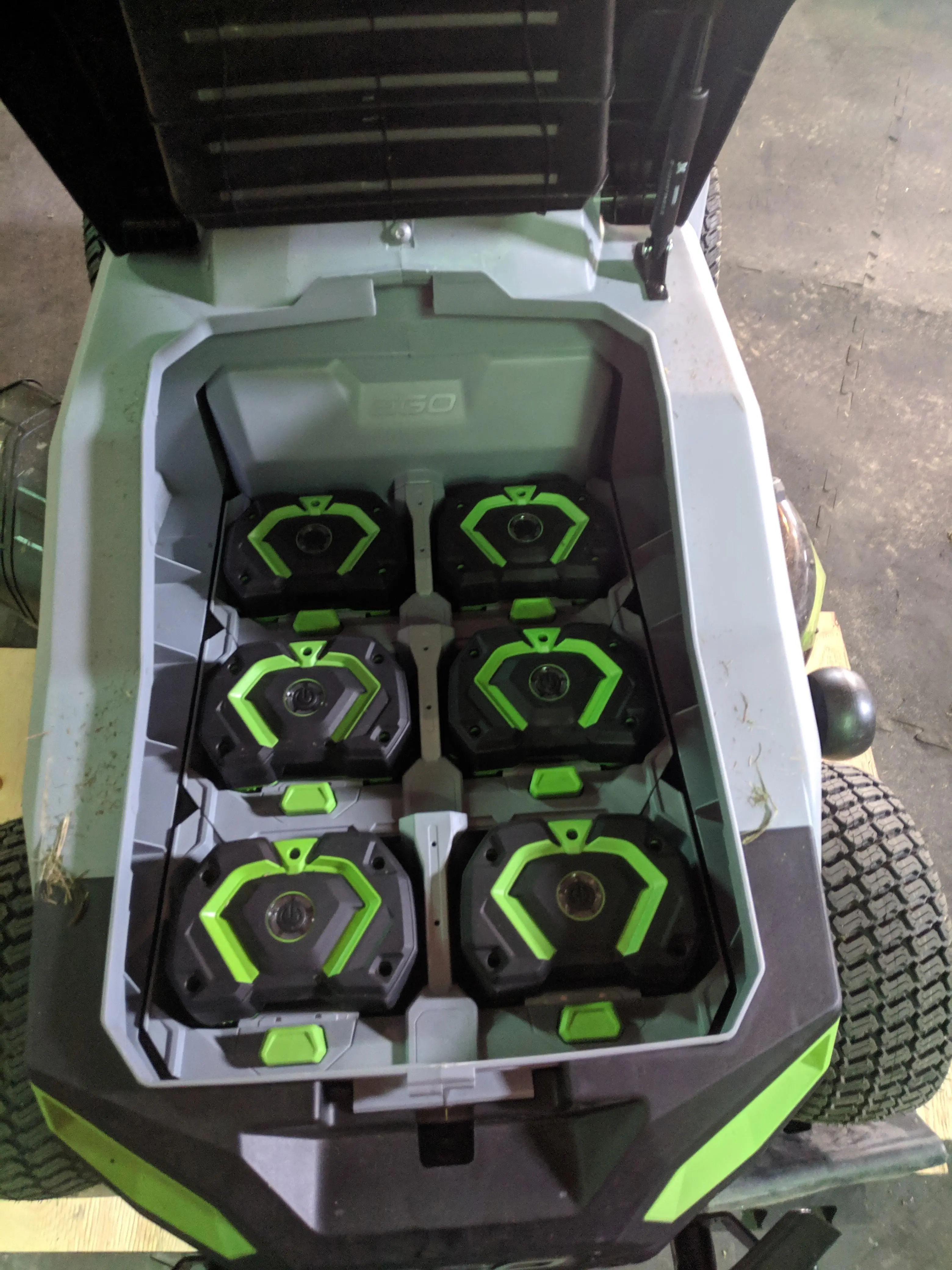Ego T6 Electric Lawn Tractor Review - Gas landscaping likely won't exist much longer
I recently bought the Ego T6 electric lawn tractor:

I have put 11hours mowing on it, and another 5h of towing things with it before writing this review. I am writing this review on my own behalf, no one paid me anything to do it.
Ego T6 Review: A mediocre lawn tractor that is a game changer
The Ego T6 was CAD$5200 at the time of purchase. It has been called "A $2500 tractor with $2500 in batteries". This review is really a review of electric lawn tractors vs. gas lawn tractors in 2024 rather than about the Ego T6 itself.
Let’s compare it to two gas based competitors, the John Deere S120 and Cub Cadet XT1LT42[1]:

Here’s the spoiler: if you are going to use your tractor for more than one year, an electric tractor is a great deal. We’ll work through the math below. I think the Ego T6 such a good deal in fact, I’m doubting whether gas tractors have much of a reason to exist anymore in a couple of years.
But first, my hardware review:
The Bad: Build Quality
The T6 feels cheaply made:
-
The T6 is made of plastic - the John Deere and Cub Cadet have metal body panels.
-
The steering on the T6 feels fairly loose
-
The braking pedal feels unresponsive
-
The stamped deck and OEM blades of the T6 seem somewhat cheap
The Annoying: EV battery maintenance
You can’t just leave the Ego T6 outside to bake in the sun the way some people do with gas tractors. The plastic body panels will wear prematurely from UV exposure. Also, obviously, the batteries will not enjoy baking in the sun.
I live in Ontario. We have hot summers[2] and cold winters [3]. Exposing lithium-ion batteries to -30C or +40C temperatures is not great. I effectively need a shelter for the tractor and a conditioned space in the house for battery storage.
With that said, let’s correct a misconception: electric motors work fine in the cold! Electric engines are vastly more reliable in a coldsnap or blizzard than diesel or gas engines, in my experience[4].
What matters is not the temperature outside, it’s the temperature of the batteries themselves. Make sure the batteries are at room temperature when you charge them or start the engine for maximum lifespan.
The Debatable: Range
Ego claims you can mow “up to 1.5 acres” on the stock batteries. This was probably measured going downhill after a drought. Here in real life, I get anywhere between 1/2 to 1 acre depending on the condition.
However, I will argue below that “lack of range on default batteries” is a not good argument against the Ego T6. Let’s move to other topics for now.
The Neutral: Looks
Also in the neutral category is the looks. The overall design can be described as “first generation Xbox”. I mean, look at the battery bank:

I doubt everyone is into this aesthetic, but I kinda like it.
The Good: Mowing Quality
I’m not an easy owner for a mower. I recently bought a neglected property with 7 acres of land. Around 2 acres require mowing already, the rest is are overgrown and need to be reclaimed. I expect to have to mow ~4 acres in the long run. I’m also often towing stuff around the property with the tractor.
Here is the T6 mowing down knee high overgrown grass like a champ:

We reclaimed a 1/2 acre parcel from a reedy swamp this spring and landscaped it into a dog agility ring used daily. The lawn is still a bunch of thick weeds, but the Ego T6 easily keeps it short:

Other places on my property are halfway reclaimed, and much harder to mow than a regular lawn:

Sometimes I get tired from using a brush cutter to fight off overgrowth and in a fit of anger I just run the mowing tractor right into thick weeds.
The picture below will certainly void my warranty. It’s is more than should be expected from any lawn tractor. Somehow, the Ego T6 mows across meter-high dense grass:

In short: I don’t think anyone could argue the Ego T6 “lacks power” with a straight face. It’s a good mower.
The Great: User Experience
The best way I can describe owning an electric tractor is that it feels free to use.
The tractor makes no noise until you start the mower. There’s no smell or sticky residue. You don’t need to think about a logistics chain of gas jerry cans.
More than that – electric tools are actually free to use when compared to using gas as an energy source (more on that below).
The electric tractor being “free” makes the user experience entirely different than owning a gas mower. I find myself making up reasons to use it. With gas tools you tend to find reasons to avoid using them - to avoid the noise, the wear on the engine, and the gas costs.
Also Great: Durability
It might seem a bit of an overreach to call the durability great on something I used 15 hours. Let me explain.
I’m a handy guy. I’ve remodeled houses, repaired cars, electronics (TV and cell phone) and everything in between. I’m having a hard time thinking up what could irreparably break on the Ego T6. Let’s get into the mechanics of it.
The mechanical engineering of a lawn tractor
The parts that break irreparably on lawn tractors are not the parts that feel cheap on the Ego T6 (body panels and steering column). Gas tractors generally die because their transmission breaks
The gas engine in lawn tractors somehow has to both make the tractor move forward and the mower blades spin from a single piece of spinning metal. This generally means a hydrostatic transmission, a complex piece of mechanical engineering that transmits power from the engine’s spinning piece of metal to hydraulic pressure in the transmission and back to spinning metal at different speeds in the wheels and mower blades.
The most efficient gas cars have engines that convert 35 to 40% of the gasonline’s energy into mechanical work. For a lawn tractor motor, the thermal efficiency is difficult to find, but it’s much lower than a car’s. I do quick math later on that estimates the thermal efficiency of a gas mower to below 5%
The other 95% of the energy from the burned gas becomes “not work”. That’s all the heat, vibrations and noise. The heat and vibration creates wear on the tool and add maintenance.
Magnet go brrrr
On the other hand, the Ego T6 has 3 brushless electric motors (drivetrain + one per mower blade)
Here is how a brushless electric motor works: you send electricity to a pair of magnets, they spin. That’s it. The magnets don’t even touch each other. Brushless motors have efficiency in the 85-90% range, which explains the lack of noise, heat, vibration and maintenance.
Having one motor per thing that has to spin is an elegant solution to the transmission problem - You just send the electricity to directly spin the thing that has to spin, whether it’s wheels or mower blades.
The efficiency of electric motors raises a question when I mention it to people:
Why is electric range so short if the engine is 20x efficient?
The answer is that gas stores around 35x more energy in a similar volume than lithium-ion batteries. The 9.1L tank of gas in the John Deere S120 stores an astounding amount of energy, but most of it becomes useless heat, noise and pollution.
The following box is energy storage math you can skip if you’re only here for the tractor review:
This means the 9.1L gas tank in the John Deere S120 is storing an astounding 86,450Wh of energy! And yet the John Deere only gets similar runtime as the 2050Wh in the six 56v 6Ah batteries of the Ego T6.
If both tractors have the same range (roughly true), and perform the same work (they do), then the thermal efficiency of the John Deere S120 is somewhere in the area of 2.2%. Even if you assume the Deere had double the range of the Ego (it doesn't), the gas tractor engine effiency is still below 4.5%.
Also Great: Towing
Towing on gas mowers is not great, because towing heavy loads will wear down a hydrostatic transmission.
Towing on the Ego T6, on the other hand, is a joy. The tractor is rated to tow 600lb, but that’s because of safety reasons. You can’t rate a lawn tractor to tow something heavier than itself, and the tractor is 600lb.
Towing on an electric tractor also takes little to no battery - I’ve done 15 trips towing 400lb loads over 200m distances and it used something like 7% of the battery.
Why Gas Tractors will phase out: Total cost of ownership (TCO)
People shop for a lawn tractor based on the sticker price. This is the wrong metric, you should look at the TCO. The TCO for electric tractors is much better.
Let’s compare the TCO of the Ego T6 to the John Deere S120. The S120 is $3800 (CAD), and the T6 is $5200:

A JD S120 has a 9.1L tank. Filling this is $15 in Ontario ($1.65/L).
The Ego T6 mows roughly the same area as the John Deere S120 with the stock batteries. The stock batteries contain 2.02kWh of energy. Electricity costs $0.12/kWh on average: “Filling the tank” costs $0.24 for the Ego T6.
When I said the T6 was “basically free to use”, I wasn’t kidding!
$14.75 saved per acre mowed
Mowing 1 acre per hour, you need to 100 hours of use to recuperate the $1500 price difference between the John Deere S120 and the Ego T6.
But what about battery durability!?
Assuming you take good care of your batteries, your batteries should have ~80% of their full capacity after 100 charging cycles.
After those 100 charging cycles you’re effectively mowing for free with the remaining lifespan of the batteries compared to a gas mower[5].
Range anxiety
The TCO of Electric Vehicles is great, but it requires a lump payment at the start when buying. This is good! We’ve transformed a difficult mechanical engineering problem in a simple financial engineering problem [6].
On the other hand driving a gas engine is basically taking credit against your future self: the gas and maintenance costs will overwhelm the inital savings over time.
The other issue is the range anxiety - what happens when you need to charge halfway through a job?
This is solved by the fact that the Ego T6 has swappable batteries - How much of a hurry you are in to cover your range needs simply becomes a battery cost up front.
Battery Cost Calculations
Electric cars tend to have their lifespan limited by their battery life. The Ego T6 fixes this by having hot swappable batteries.
This is amazing! The tool is separate from the batteries. The batteries are, and should be treated as, a commodity.
First party batteries are a ripoff
The Ego T6 is called a “$2500 tractor with $2500 in batteries”. This is only true if you pay full price for Ego batteries. Buying batteries from first party brands is generally a terrible deal.
Batteries are a big way tool brands make their margin in 2024. The brand locks the consumer into their “battery ecosystem” and charges exorbitant prices for a commodity product.
People love to argue about which brand of tools are the best, but here’s a dirty secret: Whether you’re a diehard fan of the yellow brand, the red brand or the grey brand, it’s all the same few brushless motors made in China and the batteries are all 18650 cells made from the same 4-5 Asian manufacturers:
 A 3x markup on the batteries
A 3x markup on the batteries
18650 cells are such a commodity it has its own DIY hacker scene. A 18650 pack of lithium-ion batteries should cost something like CAD$200/kWh.
On the other hand, Ego sells you batteries for around CAD$1300/kwh.
The enterprising and brave hacker could save even more money by directly replacing the 18650 cells in an ego battery. The 6Ah 56v batteries in the Ego T6 are simply a pack of 42 EVE 20P cells which will set you back between $90 and $160 ($275-$485/kwh) depending on the wholesaler.
You can also buy 3rd party knockoff ego batteries on amazon for around $600/kWh, but it’s likely worse 18650 cells than the EVE 20P.
A battery cost calculation
Say you’re a commercial landscaping operation mowing 15 acres per day - how would you compare the yearly costs of having a ton of batteries versus operating on gas?
The cells in a typical ego battery are rated to still have 60% capacity after 200 full charging cycles. You can decide at what point the batteries are considered “retired”, retiring at the 300 charging cycles point would be a conservative estimate. If you don’t take care of your batteries they will of course have a shorter lifespan.
If you save $15 per acre mowed, and battery lasts 300 charging cycles, you would save $4500 over the lifetime of a pack of six 6Ah batteries (2kWh). Deduct from this the price of the battery - you can choose to pay anywhere from full retail price ($2400) to raw battery cell price ($800) and save anywhere from $2100 to $3600 over the battery lifespan. You’d also still have used batteries with lower capacities coming out of this deal.
Modify the above numbers to your desire - the question for a commercial operation would be about the interest rate at which you can get loans to buy battery banks, and if the financing costs leave you with enough profit margin to make the switch worth the effort.
Conclusion
At this point, it’s fairly clear to me gas engines are nearing obsolescence for any machinery that’s smaller than 1 ton.
In a future post we’ll go over what I think the future will be for larger machinery.
One Acre is around 4,000m^2. I’m using the mess that is Canadian units: both meters and feet depending on what you’re measuring, celsius for temperatures except when it comes to water, liters for volume, and of course Canadian dollars. ↩︎
It’s 30c outside right now before humidity ↩︎
It’s Canada. We often get weeks where the temperature doesn’t go above -15c in January. ↩︎
To give a point of reference, I’ve once had a diesel car that required the following routine of old school Northern tricks to get started in -30c coldsnaps. First, you open the engine air intake and heat the engine with a hair dryer. Then you add a small spray of ether (not too much!) to get the first explosion going. Then you start the ignition and pray. ↩︎
When fully pricing in depreciation in the TCO we’e looking at something like $9 or $10 saved per acre mowed instead of $15. We’d also have to calculate in gas engine maintenance costs, and expected lifespan of the tool, however to make the comparison completely correct. ↩︎
Basically - get a loan to buy batteries when the interest rate over the TCO makes sense for your budget. ↩︎
